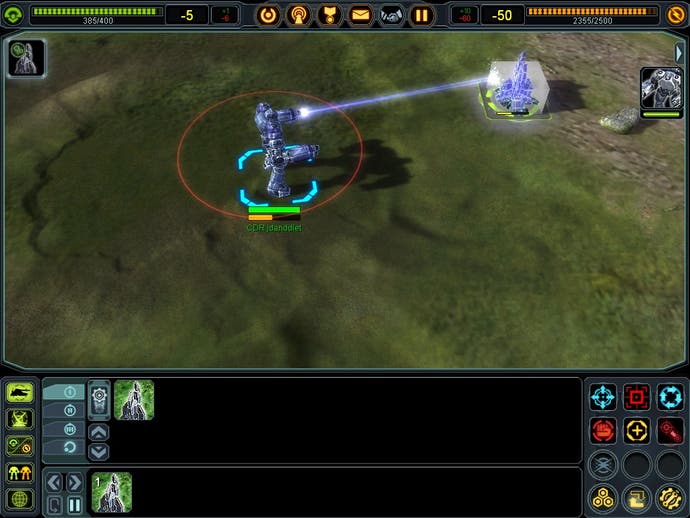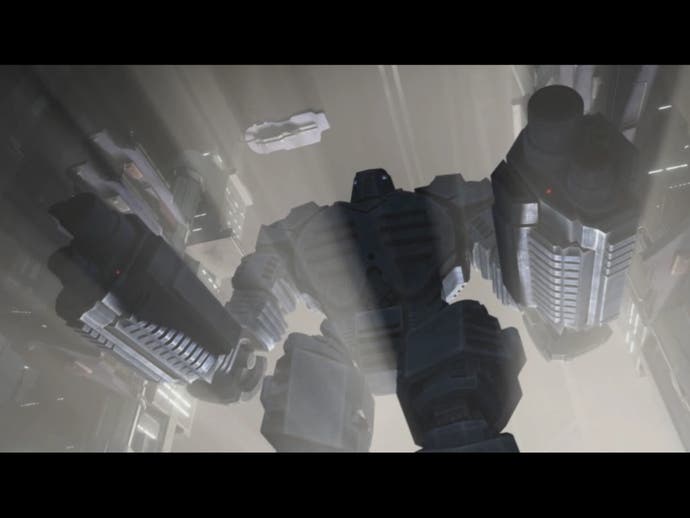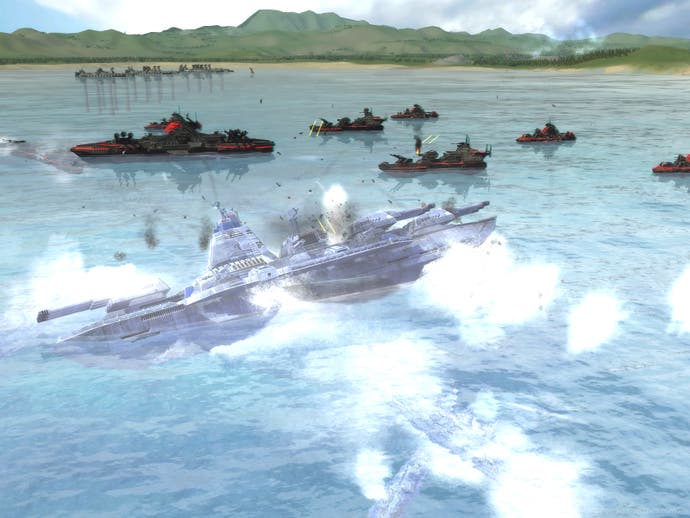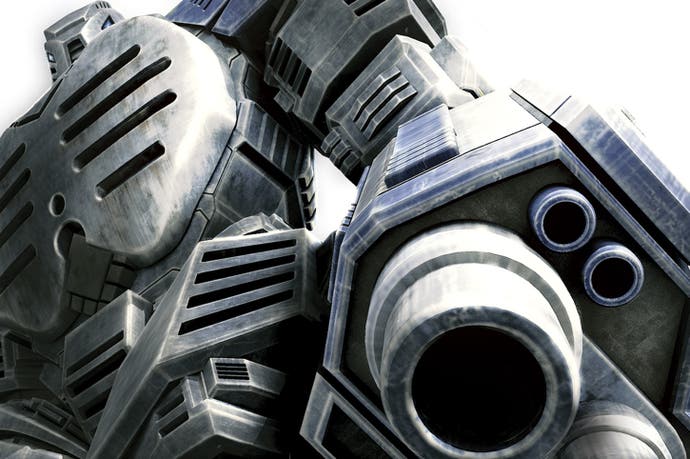The making of Supreme Commander
Mech my day.
The mid-nineties was an era when PC gaming began in earnest, kick-started by the mighty Doom's release in 1993. First-person shooters burgeoned as a result, and their combination with the real-time strategy genre conspired to make the humble home personal computer a powerful commercial gaming platform. And when it came to RTSs, the one name on most people's lips was Command & Conquer. Except for those in the know. They namechecked Cavedog's futuristic adventure, Total Annihilation as a far superior game thanks to its huge battles, terrain-based tactics and imaginative units.
I interviewed its designer and coder, Chris Taylor, a few years ago to discuss this trailblazing game; now we're chatting again, only this time to celebrate Total Annihilation's spiritual follow-up, Supreme Commander, released just over ten years ago.
"I'd been thinking about another RTS since leaving Cavedog and starting Gas Powered Games," he begins, "but it wasn't until I was completely wrapped on Dungeon Siege that I began to really think deeply about what would become Supreme Commander." Gas Powered had enjoyed reasonable success with the technically-ambitious Dungeon Siege games, and these to a certain extent influenced Taylor's next project - but more on that shortly.

Set in the far distant future, Supreme Commander would once more focus on a fractured human race, driven apart by a cybernetic fight for independence, with a mysterious band of aggressive religious zealots thrown in for good measure. For each of the three factions, the player takes control of a giant mechanoid called the Armoured Command Unit (ACU) - the Supreme Commander - using it to build units and structures, harvest resources and develop technology tiers.
Explains Taylor, "We didn't have the rights to Total Annihilation, so the best we could do was to come up with a brand new game and call it the spiritual successor. Looking back, I think that approach worked out pretty well," Nevertheless, much of Total Annihilation's original team, including Jonathan Mavor, Jeff Petkau and Jake McMahon were on board once development began in 2003.
"We knew it would be a marathon, not a sprint," says Taylor. "So we paced ourselves and worked closer to normal days of between eight and ten hours, compared to the 12-14 hours we did on Total Annihilation." As with all of his games, going way back to Hardball II and 4D Boxing in the late Eighties/early Nineties, Supreme Commander was designed from the ground up, with its central engine built from scratch. Jeff Petkau and Jon Mavor took lead roles here, on architecture and graphics respectively, while the elaborate plot, now encompassing those three factions, was worked on by a separate team. "Those guys did a phenomenal job of working to put together a completely outrageous backstory," says Taylor. "And the extra faction was because of the overall idea that the game just wanted to grow and be a much larger experience. Plus I wanted the asymmetry that came with the three different races, not too different, but different enough to really keep the experience fresh."

Supreme Commander's campaign tells the story of the United Earth Federation, or UEF, and its struggle to reassert terran control over the galaxy during a devastating war. In its way stands The Cybran Nation, a race comprised of human-machine symbionts, who are fighting for their freedom from the UEF. Thrown into this perilous situation is the Aeon Illuminate, descendants of the very first humans to encounter alien life centuries ago, who are determined to bring peace to the galaxy by destroying any who do not share their beliefs. "My favourite character, without doubt," says Taylor, "is Dr. Brackman. He was originally supposed to be just a 'head in the jar', but he ended up becoming quite a complex and bizarre character, complete with spinal column and a seductively eerie voice." The ten years between Total Annihilation and Supreme Commander meant each of its characters, including the Cybran leader Dr. Brackman, were now blessed with animation, bringing them to life further.
It wasn't just Supreme Commander's elaborate plot machinations that were engendered with such care and attention; every aspect of its gameplay was closely scrutinized by Taylor. Resource management, so much the meat and potatoes of any RTS, was closely refined. "If you think about previous RTS games, you had to have all the cash up front to make a purchase of a specific unit," explains the designer. "However, I liked the idea of pay-as-you-go, allowing the player to break ground on a big project without having the resources available to pay for it all." This core facet, together with the focus on land itself as a resource (rather than, say, Command & Conquer's ubiquitous ore fields), in a stroke eliminated the common 'turtle' tactic of most RTSs. "More land meant more resources, so you couldn't just camp in the corner," smiles Taylor. "The player needed to control a respectable area of the map just to fuel their war machine." Gas-Powered's aim was to bring battlefield strategy to the fore, with the player not having to concern themselves too much about shepherding mining vehicles around the map. "Beyond that we did a lot to take it to the next level by allowing 'in-place' upgrades for mass extractors and such, but it was generally pretty incremental from the core of the Total Annihilation resource model," says Taylor.
Another idea expanded from Total Annihilation was the use of terrain, where height values and line-of-sight were integral to any strategic manoeuvre. Again, Taylor refused to let the conventions of the genre restrict him, particularly with the game's individual units. "We pushed the whole concept of units that could move from land to sea, and vice-versa, such as the battleships that could walk around on legs. The looks I got when I told the team about that was priceless, and, yes, it's a ridiculous idea. But, hey, it's a video game - aren't we supposed to be doing crazy things and having fun?"

Gameplay aside, Supreme Commander's key technical innovation was its strategic zoom, a system modelled from 2002's Dungeon Siege. Until 2007, the majority of RTS and strategy games had employed a mini-map system to help the player marshal their forces on a grander scale. Now, it was possible to pull out from the world, alternating between a screen-wide map and close-up micro-management of the game's intense battles. "It all comes back to the player taking the role of the Supreme Commander unit," explains Taylor. "As how can you possibly be a supreme commander if you can't see the entire theatre of war?" An additional innovation, one still not seen to any great extent today, was the ability to spread the game over two monitors, thus giving a commander an even greater view of the battlefield. Inevitably, as with the aforementioned action-RPG, issues surfaced. "The guys worked pretty hard to get all the zoom code working as smoothly as they did; it went through many different engineering iterations until the rendering team got it working really well. Along with pathfinding, it was one of the big issues." Naturally, pushing the limits of then-common PC hardware was a given. Despite a constant effort to rein in the game's requirements, the ambitious visuals for an RTS, combined with the strategic zoom, left some users a little underpowered.
"But, hey, it runs good now though, right?" laughs Taylor.
Sales of Supreme Commander were solid, hitting around a million retailed copies globally, according to Taylor. It has subsequently sold approximately the same again since its release on Steam, and also received a successful expansion, Forged Alliance. There was even an Xbox 360 port by Hellbent Games, although its designer grimaces when I mention this. "That was a tough part of the SupCom history. As you can imagine, the game didn't really want to squeeze down onto that console, but in the end the team got the job done so a very large and complex strategy game could be played on it." A change of publisher (from the PC version's THQ to Aspyr) didn't help, and scotched any chance of PlayStation 3 owners getting a chance to jump into an ACU.
This wasn't the only bump in the Supreme Commander story, but today its designer has a softer view on the trials its development, perhaps understandable given his experiences since. Even smaller features, such as the game's coordinated joint attack option cost many hours of development. "Oh man, the stories I could tell you just about that one thing," grimaces Taylor. "It was insane to get it working, and I think in the end we got it working probably 70 to 80 percent of the time. In truth I don't know of many people who used it - but damn, it sounded cool at the time!"

The final facet of SupCom that sees the game remain very popular today is its community, a common RTS-based phenomenon of the era, encouraged by the game's modability. As with Total Annihilation, it was Taylor's desire to ensure the game was as customisable as possible, the result being new fan maps, missions and units even today. "There's something about RTS games that makes it possible for a community to keep coming up with great new ideas," he says. "Dungeon Siege, for example, was also very adaptable, but it never hit the same high as TA or SupCom in terms of mods."
Today, Taylor is working on a brand new RTS which he hopes to talk more about in 2018. "My goal is to take the experience to a whole new level and break the genre out of the rut it's been in for what seems like an eternity," he says. Having already done that twice with Total Annihilation and Supreme Commander, we should have high hopes the designer can achieve his objective. "With SupCom, we knew there were a few ambitious and silly features in there that we could have cut - but we didn't know they were like that until we implemented them. And why even bother making games if you're shy about something being useless or unnecessary in a game? You have to take chances, try things and see what works, especially if you want to push the boundaries and create something new and unique. People who do that truly love to explore the unknown, and those are the types of people that worked on Dungeon Siege and the SupCom games."
I can't resist it. After two hours talking to Taylor, I have to ask him: which is his favourite child, Total Annihilation or Supreme Commander? He's initially - understandably - reticent to answer. "I shouldn't answer that one," he murmurs eventually. "But I'm going to anyhow. I think it's probably TA, but mainly because the process was much more pure - with that game ideas flowed out of my brain and straight into the code, because back then I was lead design and engineer. I do think SupCom is a better game overall, but back then, that was the way it should be done, and after twenty years away from the code, I'm back working that way. And that's where I'm staying."

